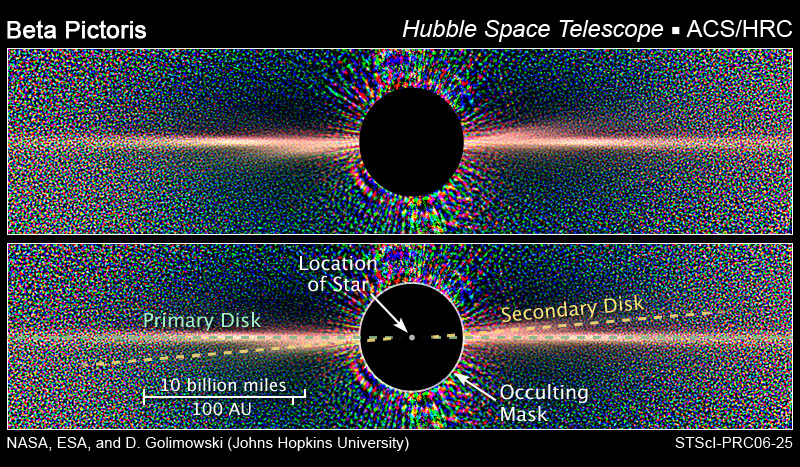|
List Of Resolved Circumstellar Disks
This is a list of Circumstellar disc, circumstellar disks that have published resolved images. Many of them are Protoplanetary disk, protoplanetary disks or Debris disk, debris disks. Only some are transitional disks between protoplanetary and debris. A few disks in this list are Circumstellar disc#Binary system, circumbinary disks. List of large disks This list contains disks with a diameter larger or equal to 2arcseconds and is sorted after their diameter in arcsecs. List of small disks There are hundreds of small resolved disks. This list only contains a selection of disks with d<2 arcsec. {, class="wikitable sortable" , + !Name !Image !RA (J2000) !Dec (J2000) !Distance (Light-year, lys) !Host Stellar classification, spectral type !Diameter (Minute and second of arc, arcsec) !Diameter (Astronomical unit, AU) !Inclination (°) !Age (Year#SI prefix multipliers, Myrs) !Type !Reference , - , HH-30, HH 30 , , , , 460 , M0 , 1.9 , 261 , 85 , , protoplanetary , [...More Info...] [...Related Items...] OR: [Wikipedia] [Google] [Baidu] |
Circumstellar Disc
A Circumstellar disc (or circumstellar disk) is a torus, pancake or ring-shaped accretion disk of matter composed of gas, dust, planetesimals, asteroids, or collision fragments in orbit around a star. Around the youngest stars, they are the reservoirs of material out of which planets may form. Around mature stars, they indicate that planetesimal formation has taken place, and around white dwarfs, they indicate that planetary material survived the whole of stellar evolution. Such a disc can manifest itself in various ways. Young star According to the widely accepted model of star formation, sometimes referred to as the nebular hypothesis, a young star (protostar) is formed by the gravitational collapse of a pocket of matter within a giant molecular cloud. The infalling material possesses some amount of angular momentum, which results in the formation of a gaseous protoplanetary disc around the young, rotating star. The former is a rotating circumstellar disc of dense gas and d ... [...More Info...] [...Related Items...] OR: [Wikipedia] [Google] [Baidu] |
AU Microscopii
AU Microscopii (AU Mic) is a young red dwarf star located away – about 8 times as far as the closest star after the Sun. The apparent visual magnitude of AU Microscopii is 8.73, which is too dim to be seen with the naked eye. It was given this Variable star designation, designation because it is in the southern constellation Microscopium and is a variable star. Like Beta Pictoris, β Pictoris, AU Microscopii has a circumstellar disk of dust known as a debris disk and at least three exoplanets, with the presence of an additional planet being likely. Stellar properties AU Mic is a young star at only 22 million years old; less than 1% of the age of the Sun. With a stellar classification of M1 Ve, it is a red dwarf star with a physical radius of 75% that of the Sun. Despite being half the Sun's mass, it is radiating only 9% as much luminosity as the Sun. This energy is being emitted from the star's stellar atmosphere, outer atmosphere at an effective temperature of ... [...More Info...] [...Related Items...] OR: [Wikipedia] [Google] [Baidu] |
Eta Corvi
Eta Corvi (Eta Crv, η Corvi, η Crv) is an F-type star, F-type main sequence, main-sequence star, the sixth-brightest star in the constellation of Corvus (constellation), Corvus. Two debris disks have been detected orbiting this star, one at ~150 AU, and a warmer one within a few astronomical units (AU). Properties Eta Corvi is only about 30% of the Sun's age. The concentration of iron and other heavy elements in its atmosphere is only about 93% that of the Sun's. The stellar rotation, projected rotational velocity at the star's equator (''v'' sin ''i'') is 68 km/s - more than 30 times faster than that for the Sun. A yellow-white main sequence star of spectral type F2V, it has an estimated effective temperature, surface temperature of 6950 K. It is 1.52 times as massive as the Sun and is 4.87 times as luminous. It is 59 light-years distant from the Solar System. The IRAS satellite detected an infrared excess, excess of infrared radiation from ... [...More Info...] [...Related Items...] OR: [Wikipedia] [Google] [Baidu] |


